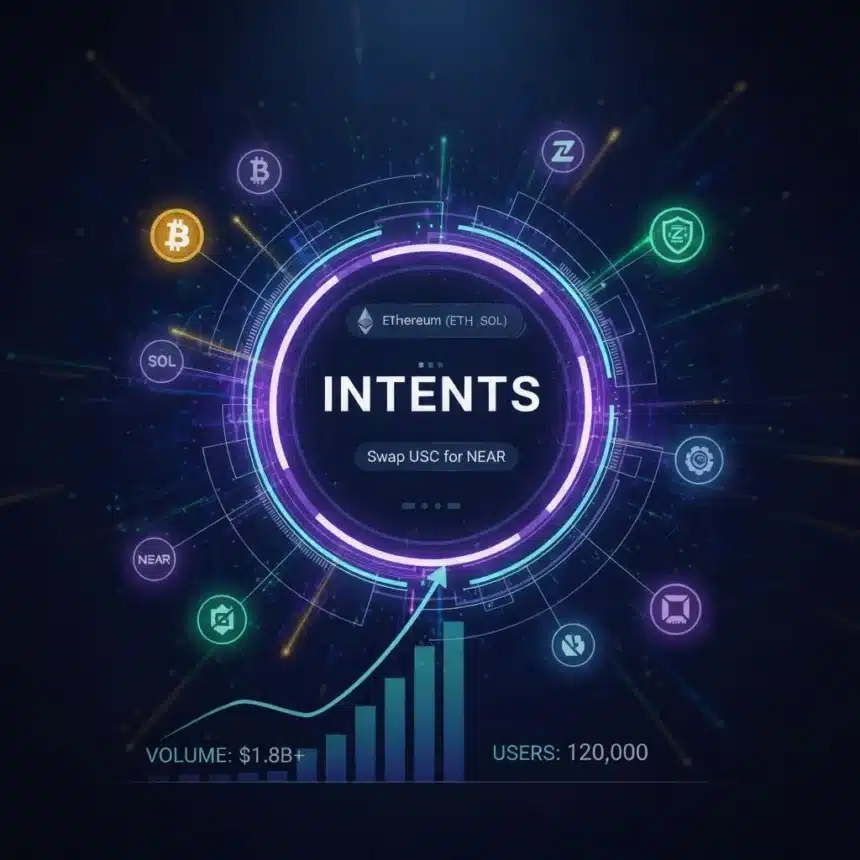Key Highlights
- Activity on NEAR’s intent system has skyrocketed, nearly doubling transaction volumes and attracting over 120,000 users.
- Growth is driven by efficiency, as the system uses “relayers” to bundle orders, reducing costs and failures.
- The current surge is fueled by the integration with Zashi, the mobile wallet for Zcash
- The Zashi-Intents shows how the complex back-end routing (Intents) can be hidden, making private and cross-chain transactions simple and usable for everyday people.
The world of decentralized finance (DeFi) is constantly evolving, but a recent surge of activity on NEAR Protocol’s “intent-based” system signals a genuine step-change in how people interact with digital assets. This isn’t just a minor technical upgrade; it’s a fundamental shift in user experience that has led to a remarkable explosion in adoption and transaction volume.
In recent weeks, the momentum around NEAR Intents has accelerated dramatically. Data reveals that transaction volumes have nearly doubled month-on-month, a clear sign that users are embracing the new approach. This massive uptake has pushed the total number of unique users well past the 120,000 mark. The financial impact is equally impressive: in the last 30 days alone, nearly $800 million in swaps and payments have been processed through the NEAR Intents infrastructure. This remarkable figure has lifted the cumulative value transacted to approximately $1.8 billion since the product was first launched earlier this year.
The Intention Revolution: Simplicity Over Complexity
The reason behind this sudden spike is rooted in a simple but powerful idea: changing the user experience from managing steps to stating goals.
In the previous era of cross-chain crypto, performing a transaction across two different blockchains was an arduous, multi-step ordeal. A user who wanted to trade, say, USDC held on the Ethereum network for NEAR tokens on the Solana network would have to manually: (1) Find a bridge to move the USDC; (2) Wait for the bridging process to settle; (3) Confirm multiple separate transactions; (4) Manage gas fees on both chains; and (5) Deal with the complexity of using multiple wallets.
NEAR Intents throws that mess out the window. Instead, a user simply states their desired outcome—their “intent.” The command becomes a plain-language request: “Swap my USDC on Ethereum for NEAR on Solana.” The underlying protocol then takes on the heavy lifting, acting like a sophisticated digital travel agent that handles all the routing, bridging, and swapping in the background, out of sight. This dramatic simplification makes decentralized finance accessible and less prone to errors for the average participant.
This seamless experience is proving “sticky,” which in crypto terms means that people aren’t just using it once for an incentive; they’re coming back consistently. The data supports this, showing that unique active users hit 113,000 in a single recent week, confirming that these are persistent, healthy flows rather than fleeting, one-off spikes motivated purely by short-term rewards.
Technical Prowess and Growing Reach
On the technical side, the system is designed for efficiency. Transactions are organized and executed by specialized components called “relayers.” These relayers bundle orders and match them intelligently, a process that significantly reduces the chance of transaction failures and, crucially, compresses the associated gas costs. This structure is precisely what is attracting a certain kind of user: professional traders and power users who need reliable, near-instantaneous cross-chain execution without the typical headache of juggling numerous wallets or enduring long settlement times.
The platform’s coverage is also expanding rapidly, both in terms of assets and supported blockchains. While stablecoins and blue-chip tokens like USDC and WETH (Wrapped Ethereum) still account for the majority of the volume, newer ecosystem tokens are quickly climbing the ranks. On the blockchain front, the system successfully bridges the three major ecosystems that currently dominate the market: Ethereum, Solana, and the privacy-focused Zcash.
The Privacy Edge: Zcash and Zashi
Perhaps the most exciting factor fueling this recent growth wave is the integration of a powerful privacy layer. This comes through Zashi, the mobile wallet developed by the Electric Coin Company for the Zcash cryptocurrency.
After a successful launch in early October, the Zashi wallet now runs two groundbreaking features directly on the NEAR Intents infrastructure:
- Zashi Swaps: This feature allows users to convert other supported assets—including Bitcoin (BTC), Solana (SOL), and USDC—directly into ZEC inside the Zashi app. Once the funds are ZEC, they can immediately be “shielded,” or made private, by the Zcash protocol.
- CrossPay: This feature truly makes private currency usable. A person can choose to spend their shielded ZEC, and the recipient is able to receive the funds in a completely different cryptocurrency on any blockchain supported by NEAR Intents.
This integration is a game-changer, especially considering that Zcash itself has been making waves, with its price recently quadrupling and bringing the privacy coin back into the mainstream market conversation.
The on-ramp and off-ramp created by the Zashi-Intents loop cleans up the user experience for everyday participants, transforming private ZEC from a secure-but-isolated asset into one that is actually viable and spendable across the wider crypto economy. The model serves as a powerful new template for all future privacy wallets: the NEAR Intents system handles the complex, multi-chain “heavy lifting” in the background, while the user-facing application (like Zashi) can focus entirely on providing an intuitive experience that meets client demand. This combination of ultimate simplicity and crucial privacy may be the defining characteristic of the next phase of decentralized finance.










